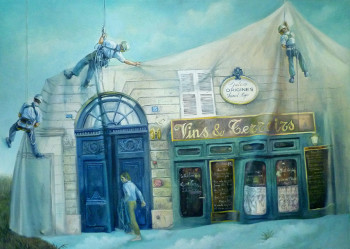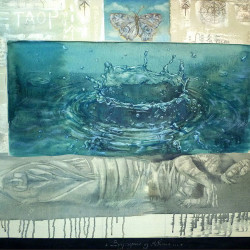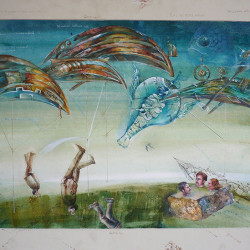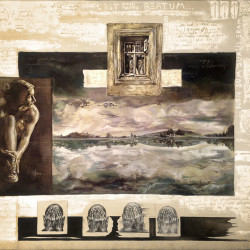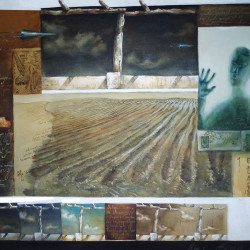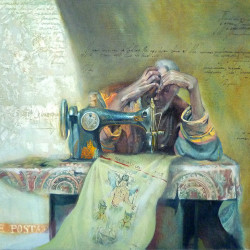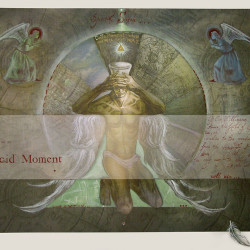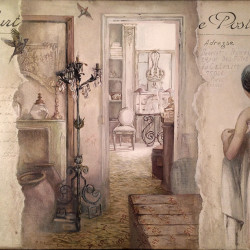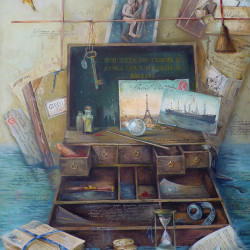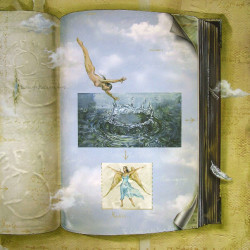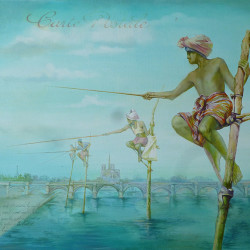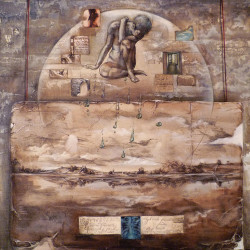Of all the photographs, I am particularly captivated by the one of Dasha Balashova at work over a midnight blue canvas, in a white room accented with other midnight blue furnishings. She simultaneously blends with and stands apart from the space she herself has created, an artist amidst, almost within, her art, and as I read the writing inscribed into the work in progress, I translate, “What you see is not what you see,” and that, to me, is the essence of Dasha Balashova’s vision.
A little bit on childhood
Dasha: “I grew up in a family full of artists, surrounded by art. My grandmother was a make up artist at the Bolshoi Theatre and I spent many hours watching the magic happen from the back of the stage, behind the curtains.”
She started her formal education at the age of three, with lessons from Pushkin’s museum, the Children’s Art Academy and feels that inhaling the depth and breadth of art history from a very early age had a significant effect on her as an artist.
On Art Education in Russia
Dasha: “Russia remains a top school for realist art, its Academic strength can be only compared to maybe art education in Italy, and I was very happy to have this opportunity to study art in Russia, to be surrounded by so much culture, it was a real treasure.”
On life Abroad
Dasha: “On the other hand, it is an incredible gift for me to be now immersed in a completely different culture, to be influenced by different perspectives and world views is tremendously inspiring. I love that I’m constantly discovering new things, and am also able to share bits of my own culture with the French.”
Evolution of Perspective
The interest in the metaphysical evolved over time. While still a young girl, Balashova studied with artists who were friends of the family, and was raised on legends and myths depicted in paintings she had learned about in art history classes. Over time she realized that art carries within itself a certain meaning, and that every painting tells a story via symbols. Later on, as she herself matured, Dasha’s work evolved into expressing her worldview through metaphors. These ideas started to percolate in the late 1990’s, when, at the age of fifteen, Balashova became a student at the Art Academy where besides learning about painting techniques, she became a serious student in the humanities: philosophy, history of religion, history of theater, literature, film studies, as well as aesthetics and ethics. She majored in Art with an emphasis in Theatre Stage Production, which meant that every semester she examined, and created sketches for a play from different time periods and countries, taking into consideration the history and culture of its country of origin.
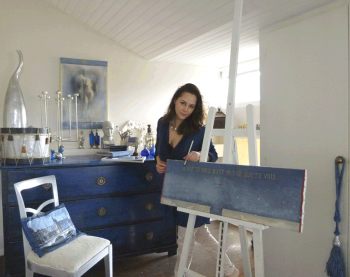 Dasha: “Being so deeply immersed in a work of art creates an environment that allows one to travel to a spiritual plane. When, at a later point in my life, I found my credo in art, I understood that I seek to recreate the essence of spirit in my work. I feel it’s important that each work shows a transformation from the material into something greater, something spiritual. All of my philosophical views on life began with the humanity studies at the Art school. At least that’s how it happened for me.”
Dasha: “Being so deeply immersed in a work of art creates an environment that allows one to travel to a spiritual plane. When, at a later point in my life, I found my credo in art, I understood that I seek to recreate the essence of spirit in my work. I feel it’s important that each work shows a transformation from the material into something greater, something spiritual. All of my philosophical views on life began with the humanity studies at the Art school. At least that’s how it happened for me.”
What else inspires you?
Dasha: “When seemingly ordinary moments in our every day life intersect with chance, the accidental and the mystery of the unknown. When we understand that each moment of our life is a small piece of a mystical puzzle which had been, long ago predetermined to happen there and then, and it is the magic of our life to follow that path. At the same time, as an artist, I believe that each person is a creator and painter of his own vision and life . I try, with each of my works, to create multi-semantic layers of meaning via metaphors, symbols, where elements of real and surreal meld together, reflecting our reality as I believe it to be. I believe our every day world is influenced by the surreal. I try to illustrate the elusiveness, fragility of the essence, along with its complexity, and its multiple dimensions. To me, life is a language of symbols and with this language I try communicate in my art.”
How does an idea for a painting develop?
Dasha: “For me, it has happened in two ways: Some paintings were created while studying at the Academy and also at the All Russian State University of Cinematography (VGIK), where I received my second diploma in cinematographic art production. Each semester we worked with a literary work, and created a scene by scene montage, taking into account the piece’s time period, history, while creating a certain atmosphere, and reflecting our own world view. So, many of the paintings on my website were inspired by major literary works, such as Chekhov, Dostoevsky, and others. Now that I’m free to do as I like, paintings originate with a concept, a feeling, an intuitive sense of what I’d like the work to look like – its atmosphere, light, etc., these feelings happen spontaneously. I sketch out ideas and then I try to understand what message I want the work to convey. Sometimes the work takes on a life of its own and that’s also very interesting.”
I mention that her paintings remind me of Paulo Coelho. Dasha smiles and nods in agreement.
Dasha: “Yes, I had the fortune of meeting with and illustrating a Children’s book he was working on for Amnesty International. Unfortunately, the funding fell through and the book is yet to be published. He is my favorite author. I had a show at an art gallery in St. Louis, Missouri, where he said that considers me the most sensitive Russian artist of the present generation. But that’s a whole other story of my life.”
Intrigued, I ask how it happened.
Dasha: “We met when I was nineteen years old. I had just finished the Art Academy and was in the process of applying to the University of Cinematography, but was not accepted the first time. I had an exhibition at an art gallery near a bookstore in Moscow. He noticed my work and proposed to work together, that had an incredible effect on my life and on my art work. I was considering pursuing a different line of work at the time, since I was rejected from the university. I took this meeting with him as a sign that I should continue on my path as an artist and I became involved with illustrating his book and delved deeper into the symbolism in art. I also met my husband at a party thrown by Paulo Coelho.”
On plans for the future.
Dasha: “In a year or two, when my sons are a little bit older, I plan to show my work more in galleries. I’m open to other projects, whatever inspires me and goes along with my thinking. Twice I’ve illustrated books. I’d love to work in theatre in some way. I’m looking forward to a new phase in my life, where I will continue to work and create art.”
Interview by Alisa Solovyeva
By MIROIR Magazine in MIROIR MAGAZINE • Lucid Dreams
198 pages, published 6/19/2014
Exclusive MIROIR Interview with Dasha Balashova, written by Alisa Solovyeva



